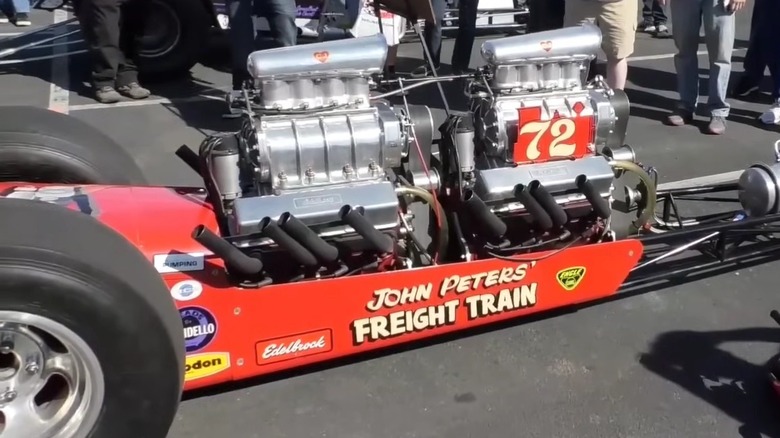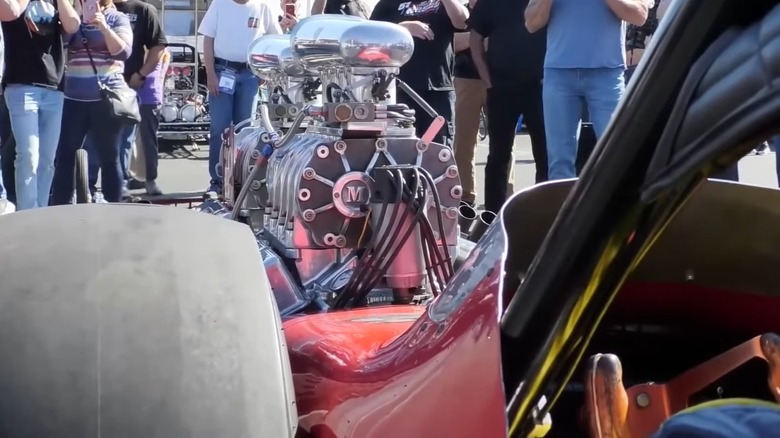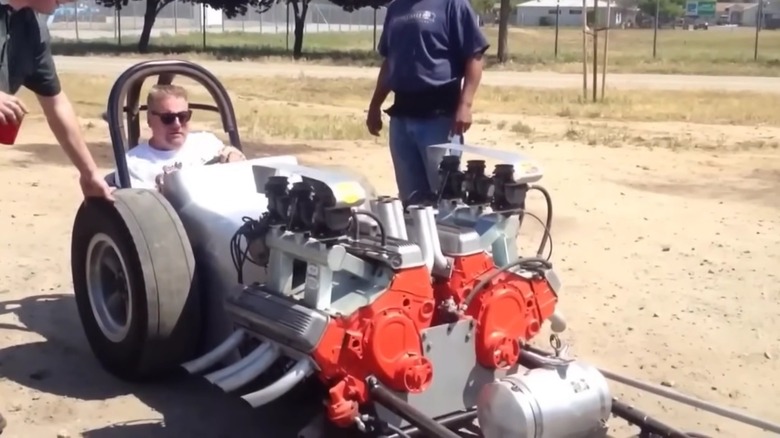How Top Gas Dragsters Managed To Make Two Engines On One Transmission Work
There's a fairly common phrase in motorsports, certainly in drag racing: "There's no replacement for displacement." Let's say you wanted to take it to the extreme. What if boring and stroking your current engine isn't enough? In that case, just put a second engine in, obviously.
It might sound somewhat ludicrous, because it is, but twin-engine dragsters have left long-lasting impacts as serious purpose-built machines, not just as gimmick cars. For example, you have Jon Smyser's Terrifying Toronado, a twin-engine 4WD 1966 Oldsmobile Toronado, a car which famously was front-wheel drive from the factory and featured many other innovations and idiosyncrasies. Same thing with the Hurst Hairy Olds, a 1966 Oldsmobile 442 with two engines and two superchargers.
These scaled all the way up to bespoke rail dragsters like the ones that made "TV" Tommy Ivo famous in the early-1960s, back before superchargers and turbochargers became commonplace as they are today on high-powered racing machines. Some of his cars even featured four engines powering all four wheels.
There are a few ways to link up a combination of two engines — for instance, you could power each set of axles by a single engine. But what about mating them to a single driveshaft? That's where it gets complicated; mating crankshafts, running combination gearboxes, and having multiple clutches to keep everything at the same RPM. Let's explore each of these and see how the magic happens.
Mating two engines to a common output shaft isn't actually that difficult
Obviously, there's no specific owner's manual when it comes to linking two engines to a single transmission in a car, but that doesn't mean it's impossible. Quite the opposite, in fact, considering several concept and racing models were actually successfully fielded with two engines in different configurations. The earliest patent for a device which can couple engines like these together to a single shifter dates back to 1929, which describes a set of mechanical linkages that join two crankshafts together to a single output shaft.
Aside from cars, coupling two engines to a single output shaft is sometimes used in specialized marine applications, with both production and at-home projects meeting with success. Aircraft have even utilized this configuration, namely the Heinkel 177, which used four engines in longitudinally-situated pairs to drive two propellers.
However, unlike these applications, fitting two engines to a single output shaft in a drag racer is considerably more difficult of a job. The issue comes from having to synchronize both engines together, which can be solved using, for instance, a modified combining gearbox similar to monster trucks, though these still require two transmissions.
The other method is to simply couple the engines by the crank, effectively making one long engine. This was done in old school Grand Prix racers like the Alfa Romeo P3, for example. Typically, it's more economical to switch to more potent fuels, for example, or to go with forced induction, rather than mounting a second engine.
The only true way of getting two engines to use one transmission
Unless you're interested in building a series of complex shafts, chains, gears, or whatever else, the simplest means to link both sets together is by mating one engine directly to another. As mentioned before, this effectively makes one long engine, and bypasses the need for combination gearboxes which are used on dragsters like tractor pullers.
In truth, it's these tractor pullers which most successfully utilize two engines or more engines with a single rear axle, so let's look at those more closely. The way it's done is that each engine has its own clutch, which then goes to its own intermediate shaft that joins up with a combination gearbox.
The clutches allow each engine to spin at slightly different RPMs so the gearbox itself isn't damaged and each intermediate shaft stays synchronized with one another. Meanwhile, there's a singular shaft that comes out the rear of the combination gearbox which runs to a conventional selector with reverse, neutral, and drive, and then to a big rig rear end. There's no transmission as such on these vehicles, just a direct link to the ring-and-pinion in the rear end.
Of course, all this precludes the ingenuity of a mechanic with enough time, skill, and money to fabricate something bespoke. But in general, you have two options — a combination gearbox, or linking the engines directly, which is how Tommy Ivo made his four-engine monstrosities. Sadly, most of these machines are pure showboat-style cars, with most racers opting instead to boost a single engine with a supercharger or turbo, which itself houses an interesting debate in drag racing circles.


